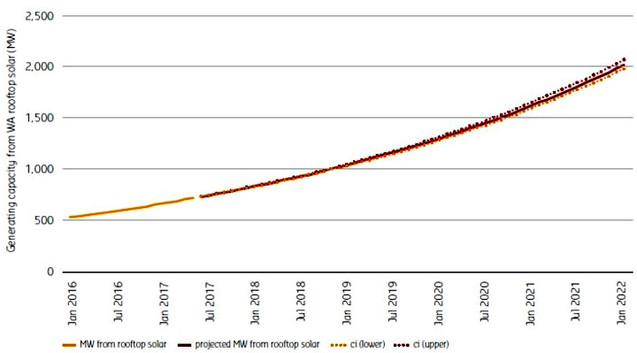RenewEconomy - Giles Parkinson
The unexpected boom in China’s solar PV installation this year may have
an unfortunate impact on the ambitious plans of many in Australia’s
surging solar sector – a bottleneck in module supplies and price rises
by the end of the year.
 |
| Source: Flickr |
The supply crunch has been predicted by market analyst IHS, as part
of its forecast for a record 90GW of solar PV to be installed across the
world in 2017, with 45GW of this to be installed in China alone.
The size of China’s installations – nearly equivalent to the size of
Australia’s entire grid capacity – has taken analysts by surprise,
because it was generally assumed that the strong first half installation
was due to the expiry of a generous geed-in tariff on July 1.
But the installation rates have continued unabated, with 11.3GW
installed in July alone, and IHS says the China demand is consuming a
large proportion of the global PV module supply, leading to increased
prices and lead times that extend into 2018.
“The latest installation forecast implies that the PV module supply
chain is at the very upper end of what it can produce within a year. In
reality, the final number of module shipments for 2017 is likely to be
limited by the supply of polysilicon.
“As a result of the tight supply, projects are being delayed” and as a
result IHS Markit has cut its forecast for installations outside of
China in 2017 by 7GW.
Australia, which is experiencing a boom in large-scale solar projects, and in rooftop solar, is also expected to be affected.
“This high China demand has a great impact on pricing and
availability in markets sourcing modules from China, such as Australia,”
says IHS analyst Josefin Berg.
“Many of the large PV projects secured modules earlier in the year,
and may not be impacted. But we do expect some of the large projects
that initially were planned for 2017 completion to be pushed into 2018.”
Solar farm developers and contractors confirmed to RenewEconomy that
the supply crunch was starting to have an impact. “Absolutely, there is
high demand for modules at the moment,” said one. “There is a global
shortage, pricing has gone up the past 6 weeks,” said on wholesaler.
According to Reneweconomy’s data, there are more than 2,300MW of
large-scale solar plants either under construction or about to build
across Australia, and another 12GW of projects in the pipeline –
although it seems clear that not all these will be built.
Most solar projects are effectively being built without subsidy,
because the off-takers are generally taking the renewable energy
certificates that will be generated by the plant.
Only those companies with deep enough pockets to fund the equity
component are able to take the “merchant risk” and sell into the
wholesale market and benefit from the current high price of LGCs.
However, few of these plants are actually under construction.
The competitive nature of the contract market is being exacerbated by
the fact that the big retailers are close to filling their legislated
mandates, and the corporate PPA market is only just emerging. This is
keeping margins fine, and a rise in module prices – even as little as 10
per cent – could have an impact on returns and pricing.
Global module pricing is also being affected by the Suniva trade case
in the US, where a tariff on Chinese module imports is being
considered.
Solar module prices have rebounded to the mid US40c/watt, a 25 to 30
per cent increase over prices just a few months earlier, which Deutsche
Bank says is driven also by stronger global demand, lack of supply chain
inventory and supply shut-downs at some Chinese companies that
are transitioning standard lines into higher efficiency lines.
“Although China demand is likely to slow down in (the second half),
demand is not falling off a cliff and the recently introduced China
target suggests that China demand would remain relatively stable in 2018
timeframe while demand in rest of the world continues to grow,” it said
in an analysis two weeks ago.
“Across the supply chain, poly, wafer and Taiwanese cell prices have
also started increasing over the past few months, reflecting the overall
tightness in solar supply chain.”
As an example of how price variations can affect project pipelines,
Deutsche says that a tariff of 10c/watt could impact 80 per cent of the
pipeline of large-scale solar projects in the US.
In Australia, however, that impact may not be so great because solar
is competing against soaring wholesale prices and huge retail prices,
meaning that the savings for business consumers in particular remain
substantial, once management turns their mind to it.
In recent months, Australian major energy users, like
Sun Metals, Telstra,
the Whyalla steel plant, Nectar Farms, and numerous smaller businesses
are also investing heavily in wind and solar and storage, some up to the
level of 100 per cent.
Four of the world’s biggest companies – Apple, Amazon, Google and
Facebook, have vowed to source all their electricity needs from
renewable energy within a few years, and they have also been joined by
the likes of IKEA and brewing giant In-Bev,
the owner of Foster’s.
Apple and Foster’s have yet to announce their plans to make their
Australian operations 100 per cent renewables, but PPAs for solar plants
are expected to feature high in their strategy.
In an earlier report, Deutsche Bank said that the global average
unsubsidised levelized cost of delivered solar would be cheaper than
coal in more than 50 markets by 2022.
This would represent 5,000GW of available market potential,
underlining a point made earlier this week by UNSW solar pioneer Martin
Green,
who expects prices to fall to $US10/MWh
in some parts of the world, with prices in the mid $US20/MWh to be
standard elsewhere, pushing the world towards annual installation
targets of 1,000GW by the mid 202s, compared to just under 100GW now.
Links








